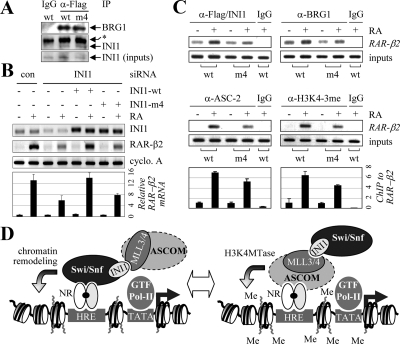Figure 7.
Importance of the MLL3/4-SET-INI1-interactions in the ASCOM-Swi/Snf cross talk supported by a specific, full-length INI1 mutant. A, Co-immunoprecipitation of BRG1 and both wild-type INI1 and the full-length INI1 mutant #4, as demonstrated using HEK293 cells expressing siINI1 and siINI1-resistant Flag-tagged wild-type or the full-length INI1 mutant #4. B, The effect of si-INI1-resistant Flag-INI1 wild-type and mutant #4 on RAR transactivation was determined by RT-PCR analyses for RA-induced expression of RAR-β2 mRNAs in HEK293 cells expressing control or anti-INI1 siRNA (39). Before RT-PCR, cells were treated with vehicle or 0.1 μm RA for 12 h. Shown below is quantitation of RAR-β2 mRNA expression by quantitative RT-PCR. C, The cells in B were also subjected to ChIP analyses for the recruitment of INI1, BRG1, and ASC-2 to RAR-β2 as well as for H3K4 trimethylation of RAR-β2. Before ChIP, cells were treated with 0.1 μm RA for 15 min (for INI1, BRG1, and ASC-2) or 1 h (for H3K4 trimethylation). Quantitation of the ChIP results for ASC-2 recruitment and H3K4 trimethylation by quantitative RT-PCR is as shown. D, The working model. ASCOM has been proposed to function as a platform to recruit other coactivators during NR transactivation (4). This study reveals that the direct protein-protein interactions between INI1 and the MLL3/4-SET domain enable a novel cross talk between ASCOM and Swi/Snf. This cross talk functions at least in part through mutually facilitating recruitment of these two complexes to NR target genes, although the exact sequence of events (for instance whether Swi/Snf functions before ASCOM) is not known.

